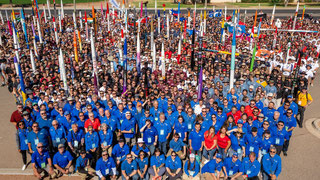Can the way we generate energy be FUNDAMENTALLY transformed?
We believe the world will be much better if global clean energy generation is dramatically improved beyond current choices – and that’s why we’re developing this XPRIZE.
On a planet awash with energy, in a universe where all matter is made of immense amounts of energy (E=mc2), we find our society forced to make bad choices for most of our energy supply from a set of technologies as old as the transistor, not to mention fire.
There are countless reasons why we need new and better sources of energy, from climate change to pollution to poverty and more. The vast majority of mankind’s current energy use is coming from unsustainable and damaging sources. We need something better.
An XPRIZE is a great way to inspire new solutions
Great prize competitions have worked to spawn entire new industries from ideas of inventors who entered. XPRIZE Foundation is a global leader in designing and executing fair, well-designed incentive prize competitions.
But what would a prize competition for abundant clean energy look like in detail? To design a highly effective competition in detail takes a lot of thought and work and we need your input and help.
Well-designed competitions have a way of breaking new ground that seems impossible. They attract the best and brightest minds, challenging and supporting them to push all the limits. Lots of promising ideas are on the drawing boards of inventors, small companies and scientific researchers. They exist. How do we draw them out and validate them so they can get the support they need to scale up and serve this huge need/market? What better way than a well-designed, very large XPRIZE?
Please help make this prize competition THE BEST it can be
We are in the process of designing this XPRIZE. We recognize that we don’t have all the answers so we’re asking for your help. We invite thoughtful advice from experts like you that can help us set up a prize competition to get the greatest results.
We are looking for ideas on how to design the prize to:
1. Attract the BEST, most transformative new clean energy technologies and inventions
2. Optimally incentivize the most talented inventors/scientists/engineers to participate
3. Clearly define prize competition structure and rules
4. Set up scientific protocols to test and verify/validate entries
5. Set up judging criteria to efficiently evaluate and sort through entries while not discouraging “adventurous” submissions
What’s in it for YOU?
We are putting up a $50,000 prize purse that is broken into pieces to incentivize YOU to help come up with better and better ideas on how to accomplish these objectives.
- Start thinking of your ideas on how to best run a prize of this magnitude
- It’s simple - The more great ideas and collaboration you share, the more points you get. The more points you get, the more money you get - and the more you help the world.
Easy steps for you to get involved
Step 1. Review the challenge Guidelines and start thinking of optimal ways to run a prize competition like this.
Step 2. Sign up by clicking the orange “Accept Challenge” button above and share with others who may be interested by using the social media buttons.
Step 3. Collaborate with others. Add to the Wiki and the message board; contribute your ideas and earn points. Discuss and expand the ideas of others and get more and more points.
Step 4. Begin a competition design entry by clicking the orange “Accept Challenge” button above.
Step 5. Win cash prizes for your contribution to helping the world.
Dive deeper if you’d like
Here is more info on what we aim to achieve and how.
Designing the Abundant Clean Energy XPRIZE Competition
We’re having a competition to design a competition!
XPRIZE believes in the power of competition and that you get what you incentivize. To solve this grand challenge of designing an XPRIZE Competition for Abundant Clean Energy, we want to encourage and reward the creation, development, and verification of new energy technologies capable of providing clean, abundant, safe and affordable energy to all.
We are asking you to help design a competition that creates this incentive. The best competition designs will include a competition structure and guidelines that articulate exactly what is required from competitors, how competitors will be evaluated and judged, and dollar amount for the prize purse(s),
Because we are seeking revolutionary, breakthrough ideas in energy, we are also looking for ways to test and verify exactly how a demonstration of net positive energy generation by any competitor would be verified and measured. The Positive Energy Test may be an idea of your own, or adapted from academic literature, established industry standards, or other methods shared on the Wiki (see below for a description of the Abundant Clean Energy Wiki, which is an important component of this design challenge).
Competition design entries will be judged by XPRIZE by following the spirit of three key design questions.
(1) Is the design concept “prize-able”, i.e. has the entry demonstrated that their incentive prize competition design has the ability to create clear, effective incentives for this challenge?
(2) Can the proposed prize competition be successfully executed, i.e. has the entry articulated a way to practically and efficiently incentivise the creation, development, and verification of new energy technologies capable of providing Abundant Clean Energy to all?
(3) Will the prize credibly validate the production of net positive energy from a new source, i.e. is there a scientifically valid method for measuring competitor performance that can be used to award a prize with confidence?
To be eligible for a Competition Design Prize you must contribute to the Abundant Clean Energy Wiki. We invite you to join your peers in science, engineering, design, business, and more to compete and collaborate to create the best Abundant Clean Energy competition!
Join an Online Community
The opportunity to join this online community is open to anyone, and many of us are aware of tantalizing avenues for energy research, but no one has time to follow more than a few of them in depth.
A New Way to Collaborate
The Wiki effort is not a diffuse brainstorm, or a formal literature review. Instead, our goal is a Wiki that supports a temporary community of collaborators and competitors in a way that combines the insights and knowledge of many great minds in a respectful and open-minded way. A key piece of this collaboration will be the design of new tests and methodologies that competitors in a future XPRIZE Competition can use to prove the viability, safety, and potential of any new energy technology.
Grounding in Research and References
Designing a prize to encourage solutions to a grand challenge starts with lots of research. We believe it is important for each competitor to have access to all of the combined research so that everyone can spend more time and energy considering the best way to design the prize. Collecting citations, relevant references and background research is so important that this challenge has two prizes dedicated to those who contribute the most.
$10,000 Quick Start Prize
To encourage the early sharing of your research, there will be a $10,000 Quick Start Wiki Contribution Prize awarded to the competitor who contributes the most by February 28th. To be eligible for the $10,000 Quick Start prize, click here to submit your entry before the February 28, 2017 deadline. A Final Wiki Contribution Prize of an additional $10,000 will be awarded based on who contributes the most to the Wiki overall. Entries for the Final Wiki Contribution Prize are submitted on this page.
Get Started
To make contributions to the Wiki, first create a HeroX account. Then, while signed in to your HeroX account, create a Wiki account by clicking here. Until then, you may read the Wiki but cannot contribute to it.
Competition Timeline
| January 12, 2017 |
Submission Period Begins |
| February 28, 2017 |
Deadline to submit for $10,000 QuickStart Wiki contribution prize Enter Here |
| April 11, 2017 |
Deadline to submit a Challenge Design or Wiki contribution entry |
| May 31, 2017 |
Winner Announcement |
Prize Purses
QuickStart Wiki Contribution Prize - $10,000 - Deadline of February 28th Enter Here
Final Wiki Contribution Prize - $10,000 - Deadline of April 11th
Competition Design Prizes - 3 at $10,000 each - Deadline of April 11th
XPRIZE Visioneers Invitation Prize: In addition to the prize purses described here, the most creative and visionary competitors may be invited to participate in the XPRIZE Visioneers summit as presenters or mentors to Visioneers teams.
How do I win a Wiki prize?
Wiki prizes will be selected from submitted entries based on the number of additions made, taking into account the quality and quantity of the contributions and unique references cited. The Wiki Contribution Leaderboard tracks the number of pages edited and the number of additions made by competitors. An expert panel will be used to evaluate the scientific relevance and veracity of entries made.
How do I win a Competition Design prize?
To be eligible to win a Competition Design prize, you must do two things: (1) contribute meaningfully to the research Wiki, and (2) submit a Competition Design. Your Competition Design will be evaluated according to the Scoring Criteria outlined below.
Each Competition Design will contain:
- Title - A short, engaging name that describes the goal of the challenge.
- Executive Pitch - A clear, concise description of the competition. Anyone reading this Pitch should have an instant understanding of what the competition is about and a good idea of what it will take to win.
- Prize Purse - How much money do you think is necessary to incentivize the desired breakthroughs? How will the prize purse be distributed?
- Prize Purse Justification - Why is the submitted prize purse value the right fit for the challenge?
- Structure - What is the basic competition structure? Does the first competitor to achieve a certain level of performance win, or does the best competitor at a certain deadline date win? Or other structure? Will your challenge have multiple phases? Perhaps there’s an elimination phase or time and money to support implementation? Check out the CHIME National Patient ID Challenge, IGNITE, and the Autism Speaks House to Home Prize for three of the many ways to structure a challenge.
- Recommended Duration - How long should your challenge run to allow innovators time to design, develop, refine, and test their solutions? Maybe it’s only six months, or maybe it’s years or until a winner meets a net energy output threshold?
- Guidelines - What needs to be done to win the challenge? The guidelines should provide clear, objective and measurable goals.
- Verification - What is the method of verifying the positive net energy generation of competing technologies given that they may well be quite different? Is the method unique to each technology, or consistent across technologies? How can it be assured to be repeatable?
- Supporting Information - Want to submit a schematic of a verification method, or a link to a video of yourself giving an elevator pitch of your design? Just attach them to your entry when prompted.
Comptetition Design Scoring Criteria
|
|
Wiki – 20%
Scoring will be based on the number of additions made, taking into account the quality and quantity of the contributions and unique references cited.
|
|
Novelty – 5%
Does the competition design incentivize the development and demonstration of truly breakthrough clean energy solutions?
|
|
Competition Structure – 15%
Will the structure of the competition create clear, highly effective incentives for developing new clean energy concepts and technologies?
|
|
Validation Plan – 20%
Does the articulated plan to validate technical performance appropriately balance the need for unequivocal technical rigor with the desire to fairly evaluate novel, transformational solutions?
|
|
Operability – 15%
Do the structure, validation plan, prize purse amount, and duration lend themselves to a prize competition that can be practically and highly effectively executed?
|
|
Scientific Rigor – 20%
Does the competition reflect a sound understanding of scientific and engineering principles, particularly in the case of evaluating novel phenomena?
|
|
X-Factor – 5%
Are there other notable aspects of the competition design that could drive valuable technological, environmental, social, narrative, public engagement or other benefits during a prize competition?
|
Design Competition Rules
Eligibility
The Challenge is open to all individuals age 18 or older. Innovators may originate from any country. Submissions must be made in English. All prize-related communication will be in English.
To be eligible to compete, you must comply with all the terms of the Challenge as defined in the Challenge-Specific Agreement.
Registration and Submissions:
All competitors must be registered prior to submitting an entry. Final submissions must be received on or before April 11, 2017 at 4:59 pm EDT. No late submissions will be accepted.
Submissions must be made online via upload to the HeroX.com website. All document uploads must be in PDF format (2 MB maximum). Minimum margins are one inch. Font must be minimum 12 pt, single-spaced (text in tables and figures may be as small as 9 pt).
Any video submissions must first be uploaded to YouTube, Vimeo, or other video sharing site. Double-check that all of your links are working and that they are set to Public.
Selection of Winners and Judging:
Winners will be judged by the XPRIZE team, including professionals with expertise in energy science and engineering, and developing and operating prize competitions and Grand Challenges.
Wiki prizes will be selected from submitted entries based on the number of additions made, taking into account the quality and quantity of the contributions and unique references cited. An expert panel will be used to evaluate the scientific relevance and veracity of entries made.
Winners will be announced on May 31, 2017.
Additional Information:
- No purchase or payment of any kind is necessary to enter or win the competition.
- Void wherever restricted or prohibited by law.
- By participating in the challenge, each competitor agrees to submit only their own original ideas. All applications will go through a process of due diligence. Any application found to be misrepresentative, plagiarized, or sharing an idea that is not their own will be disqualified. Ineligible or disqualified applicants will be removed from the competition with no recourse or reimbursement.
- Any indication of "copying" amongst competitors will be grounds for disqualification.
- HeroX reserves the right to unequivocally disqualify any entry that HeroX in its sole discretion determines has contravened the Wiki rules, or has otherwise tried to circumvent the rules to gain advantage.
- The Sponsor will require all content and assets submitted as part of a Finalist’s Design Submission to be released under open source licenses that permit free distribution, derivative works, and use in commercial and non-commercial settings.
- All Innovators are welcome and encouraged to depend on or make use of other components, libraries, content, assets, and code. All such materials must be available under any Open Source Initiative (OSI) or Creative Commons license compatible with the OSI or Creative Commons license under which the Submission will be released. “Compatible” means that each Innovator’s entire Submission must be usable without violating the license terms of those components licensed under the CC BY 4.0 license, Apache License 2.0, or respective OSI license for the components. Source code licensed under the LGPL, BSD, MIT, or Apache licenses currently meets this criterion; other open source licenses may also meet it. If Innovators make modifications to existing open source projects, they are strongly encouraged to submit patches upstream and work to have them accepted. Patches that are not accepted upstream may be submitted as part of the code developed by the Innovator, under the same Apache License 2.0. Content and assets must be licensed under terms that permit commercial usage. The Creative Commons CC BY and CC-BY-SA licenses currently meet this criterion. Innovators cannot submit entries that include or rely on software or content that is either closed-source, proprietary, illegally sourced, or depends on per-seat licensing.









